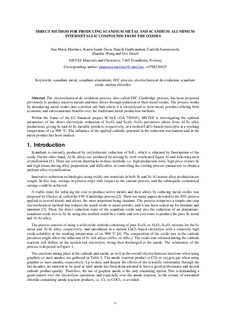| dc.contributor.author | Martinez, Ana Maria Cuellar | |
| dc.contributor.author | Osen, Karen Sende | |
| dc.contributor.author | Gudbrandsen, Henrik | |
| dc.contributor.author | Sommerseth, Camilla | |
| dc.contributor.author | Wang, Zhaohui | |
| dc.contributor.author | Darell, Ove | |
| dc.date.accessioned | 2019-12-20T14:51:05Z | |
| dc.date.available | 2019-12-20T14:51:05Z | |
| dc.date.created | 2018-03-22T14:38:01Z | |
| dc.date.issued | 2018 | |
| dc.identifier.citation | Light Metals. 2018, 1559-1564. | nb_NO |
| dc.identifier.issn | 0147-0809 | |
| dc.identifier.uri | http://hdl.handle.net/11250/2634348 | |
| dc.description | The final publication is available at Springer via http://dx.doi.org/10.1007/978-3-319-72284-9_203 | nb_NO |
| dc.description.abstract | The electrochemical de-oxidation process, also called FFC-Cambridge process, has been proposed previously to produce reactive metals and their alloys through reduction of their metal oxides. The process works by introducing metal oxides into a molten salt bath where it is electrolysed to form metal powders offering both economic and environmental benefits over the traditional metal production methods. Within the frame of the EU-financed project SCALE (GA 730105), SINTEF is investigating the optimal parameters of the direct electrolytic reduction of Sc2O3 and Sc2O3–Al2O3 precursors (dross from Al-Sc alloy production), giving Sc and Al-Sc metallic powders, respectively, in a molten CaCl2-based electrolyte at a working temperature of ca. 900 °C. The influence of the applied cathodic potential in the reduction mechanism and in the metal product has been studied. | nb_NO |
| dc.language.iso | eng | nb_NO |
| dc.publisher | Springer | nb_NO |
| dc.rights | Attribution-NonCommercial-NoDerivatives 4.0 Internasjonal | * |
| dc.rights.uri | http://creativecommons.org/licenses/by-nc-nd/4.0/deed.no | * |
| dc.subject | Scandium metal | nb_NO |
| dc.subject | Scandium-aluminium | nb_NO |
| dc.subject | FFC-process | nb_NO |
| dc.subject | Scandium oxide | nb_NO |
| dc.subject | Molten chlorides | nb_NO |
| dc.subject | Electrochemical de-oxidation | nb_NO |
| dc.title | Direct Method for Producing Scandium Metal and Scandium-Aluminium Intermetallic Compounds from the Oxides | nb_NO |
| dc.type | Journal article | nb_NO |
| dc.type | Peer reviewed | nb_NO |
| dc.description.version | acceptedVersion | nb_NO |
| dc.rights.holder | © The Minerals, Metals & Materials Society 2018 | nb_NO |
| dc.source.pagenumber | 1559-1564 | nb_NO |
| dc.source.journal | Light Metals | nb_NO |
| dc.identifier.doi | https://doi.org/10.1007/978-3-319-72284-9_203 | |
| dc.identifier.cristin | 1575053 | |
| cristin.unitcode | 7401,80,4,4 | |
| cristin.unitcode | 7401,80,63,0 | |
| cristin.unitname | Elektrolyse og høytemperaturmaterialer | |
| cristin.unitname | Industriell prosessteknologi | |
| cristin.ispublished | true | |
| cristin.fulltext | postprint | |
| cristin.qualitycode | 1 | |

